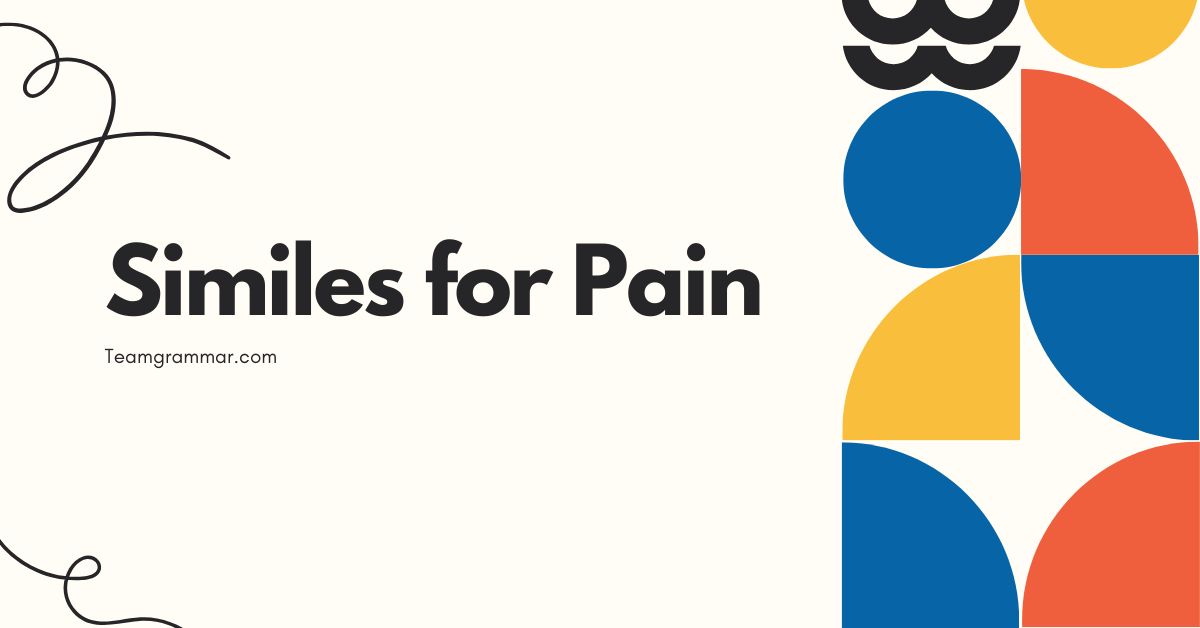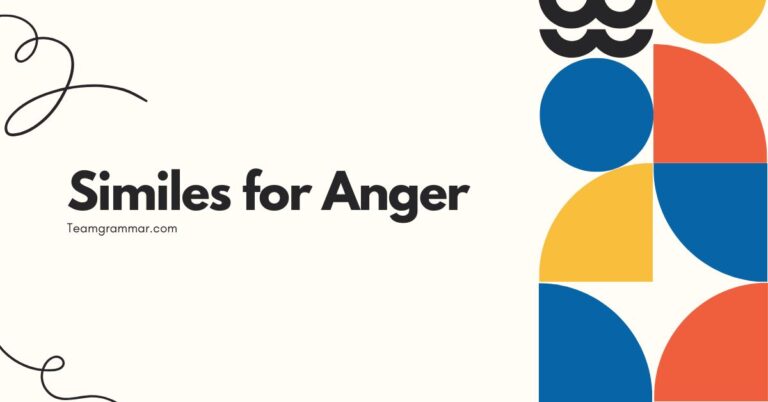35 Similes for Pain: A Comprehensive Guide to Expressive Language
Understanding how to effectively convey the sensation of pain is crucial for both writers and speakers. Similes, comparisons using “like” or “as,” offer a powerful tool to articulate the often indescribable experience of pain.
This article delves into the nuances of using similes to describe pain, exploring various categories, structural elements, and common pitfalls. Whether you’re a student, writer, or simply someone looking to expand their vocabulary, this guide provides a comprehensive overview of similes for pain, enhancing your ability to express and understand this universal human experience.
This article is designed for English language learners, writers, and anyone interested in expanding their vocabulary and improving their descriptive writing skills. By mastering the art of using similes to describe pain, you can add depth and emotional resonance to your communication, making it more vivid and impactful.
Table of Contents
- Definition of Similes for Pain
- Structural Breakdown of Pain Similes
- Types and Categories of Pain Similes
- Examples of Pain Similes
- Usage Rules for Pain Similes
- Common Mistakes When Using Pain Similes
- Practice Exercises
- Advanced Topics in Pain Similes
- Frequently Asked Questions (FAQ)
- Conclusion
Definition of Similes for Pain
A simile is a figure of speech that compares two unlike things using the words “like” or “as.” In the context of pain, a simile aims to make the abstract sensation of pain more relatable and understandable by comparing it to something concrete or familiar. The effectiveness of a pain simile lies in its ability to evoke a vivid sensory experience in the reader or listener, bridging the gap between personal experience and shared understanding.
Similes are essential tools for conveying the intensity, quality, and impact of pain. They allow us to move beyond simple descriptions like “it hurts” and delve into the specific characteristics of the pain.
For example, instead of saying “My head hurts,” you could say “My head feels like it’s being squeezed in a vise,” which provides a much more descriptive and impactful image.
The function of a pain simile goes beyond mere description. It also serves to create empathy and understanding.
By using a relatable comparison, you can help others grasp the severity and nature of your pain, even if they haven’t experienced it themselves. This can be particularly important in medical settings, where accurate communication of pain is crucial for diagnosis and treatment.
Structural Breakdown of Pain Similes
The basic structure of a pain simile consists of two main components: the subject (the pain itself) and the comparative element (the thing being compared to the pain). These two elements are connected by the words “like” or “as.” Understanding this structure is essential for creating effective and impactful similes.
Here’s a breakdown of the structural elements:
- Subject: This is the pain being described. It can be a specific type of pain (e.g., headache, muscle ache) or a more general sensation of pain.
- Comparative Word: This is either “like” or “as,” which signals that a comparison is being made.
- Comparative Element: This is the object, concept, or experience that the pain is being compared to. It should be something that the audience can easily understand and relate to.
For example, in the simile “The pain was like a burning fire,” the subject is “the pain,” the comparative word is “like,” and the comparative element is “a burning fire.” The effectiveness of this simile lies in the shared understanding of the intense heat and destructive nature of fire, which helps to convey the severity of the pain.
The order of these elements can sometimes be varied for stylistic effect, but the core structure remains the same. For instance, you could say “Like a burning fire, the pain raged through my body.” The key is to ensure that the comparison is clear and easily understood.
Types and Categories of Pain Similes
Pain similes can be categorized in various ways, depending on the type of pain they describe and the focus of the comparison. Here, we will explore three main categories: physical pain similes, emotional pain similes, and a comparison between similes that describe acute versus chronic pain.
Physical Pain Similes
Physical pain similes focus on describing the sensations associated with bodily pain. These similes often draw comparisons to sharp objects, intense heat, pressure, or other physical sensations.
The goal is to evoke a visceral understanding of the pain’s intensity and quality.
Examples of physical pain similes include:
- “The pain was like a knife twisting in my gut.”
- “My head felt as if it were splitting open.”
- “The burn was like a thousand needles pricking my skin.”
These similes rely on our shared understanding of physical sensations to convey the experience of pain. The more vivid and specific the comparison, the more effective the simile will be.
Emotional Pain Similes
Emotional pain similes, on the other hand, aim to describe the feelings associated with emotional distress, such as sadness, grief, or heartbreak. These similes often draw comparisons to feelings of emptiness, weight, or darkness.
The challenge with emotional pain similes is that they are inherently more abstract than physical pain similes, requiring a greater degree of creativity and sensitivity.
Examples of emotional pain similes include:
- “The grief was like a heavy blanket smothering me.”
- “My heart felt as if it were shattered into a million pieces.”
- “The loneliness was like a vast, empty desert stretching out before me.”
These similes attempt to capture the intangible nature of emotional pain by comparing it to tangible objects or experiences. The effectiveness of an emotional pain simile depends on its ability to resonate with the reader’s own emotional experiences.
Acute vs. Chronic Pain Similes
Another way to categorize pain similes is by distinguishing between those that describe acute pain (sudden and short-lived) and those that describe chronic pain (long-lasting and persistent). Acute pain similes tend to focus on the intensity and suddenness of the pain, while chronic pain similes often emphasize the weariness and ongoing nature of the suffering.
Acute Pain Similes:
- “The pain shot through my leg like a lightning bolt.”
- “It felt as if someone had stabbed me in the back.”
- “The headache came on like a sudden explosion.”
Chronic Pain Similes:
- “The pain was like a constant hum in the background of my life.”
- “It felt as if I were carrying a heavy weight on my shoulders every day.”
- “The ache was like a dull, persistent throb that never went away.”
The key difference lies in the temporal aspect of the pain. Acute pain similes focus on the immediate impact, while chronic pain similes highlight the enduring nature of the suffering.
Examples of Pain Similes
This section provides extensive examples of pain similes, organized by category, to illustrate the diverse ways in which this figure of speech can be used to describe pain effectively. Each table contains a variety of similes, showcasing different approaches and levels of intensity.
Physical Pain Examples
The following table presents a range of similes used to describe various types of physical pain. These examples aim to provide a vivid and relatable understanding of the sensations involved.
| Simile | Type of Pain |
|---|---|
| The pain was like a hot iron searing my flesh. | Burn |
| My head felt as if it were being crushed in a vise. | Headache |
| The cramp was like a knife twisting in my calf. | Muscle Cramp |
| My joints ached as if they were filled with sand. | Joint Pain |
| The sting was like a swarm of bees attacking my skin. | Insect Sting |
| The throbbing was like a drumbeat in my ear. | Earache |
| My toothache felt as if someone were hammering a nail into my jaw. | Toothache |
| The cut burned like acid on my skin. | Cut/Wound |
| My back pain was like a rusty hinge, grinding with every movement. | Back Pain |
| The pressure felt like an elephant sitting on my chest. | Chest Pain |
| The soreness was like a thousand tiny pinpricks all over my body. | Muscle Soreness |
| The bruise throbbed like a second heartbeat beneath my skin. | Bruise |
| My stomach churned as if it were filled with razor blades. | Stomach Pain |
| The sunburn felt as if my skin were being peeled off. | Sunburn |
| The arthritis pain was like ice creeping through my bones. | Arthritis |
| The pain in my foot was like walking on shards of glass. | Foot Pain |
| The sore throat felt like swallowing sandpaper. | Sore Throat |
| The burn from the radiation felt like a slow, simmering fire. | Radiation Burn |
| The headache pulsed as if a tiny hammer were striking inside my skull. | Tension Headache |
| My muscles felt as tight as guitar strings stretched to their limit. | Muscle Tension |
| The frostbite stung like a million needles piercing my skin. | Frostbite |
| My knee felt as unstable as a house of cards in a hurricane. | Knee Injury |
| The pain after surgery felt like a dull saw chewing through bone. | Post-operative Pain |
| The migraine pounded like a relentless tribal drum deep inside my head. | Migraine |
| The pulled muscle felt as if someone had tied a knot in my leg. | Pulled Muscle |
This table offers a diverse range of physical pain similes, illustrating how different sensations can be effectively conveyed through comparison.
Emotional Pain Examples
The following table provides examples of similes used to describe emotional pain. These similes aim to capture the intangible nature of emotional distress by comparing it to tangible objects or experiences.
| Simile | Type of Pain |
|---|---|
| The heartbreak was like a deep wound that refused to heal. | Heartbreak |
| The loneliness felt as if I were the last person on earth. | Loneliness |
| The grief was like a heavy cloud hanging over my head. | Grief |
| My spirit felt as if it were crushed under a mountain of despair. | Despair |
| The disappointment was like a cold wave washing over me. | Disappointment |
| The regret was like a constant whisper in my ear. | Regret |
| My anxiety felt as if my mind were a runaway train. | Anxiety |
| The shame burned like a brand on my soul. | Shame |
| The fear was like a dark shadow lurking in the corners of my mind. | Fear |
| The sadness felt as if my heart were made of lead. | Sadness |
| The emptiness was like a void that could never be filled. | Emptiness |
| The betrayal stung like a slap in the face. | Betrayal |
| The anger boiled inside me like a volcano ready to erupt. | Anger |
| The frustration felt as if I were banging my head against a brick wall. | Frustration |
| The insecurity was like a parasite feeding on my confidence. | Insecurity |
| The rejection cut as deeply as a surgeon’s scalpel. | Rejection |
| My hope dwindled like a candle flame in a strong wind. | Loss of Hope |
| The guilt weighed on me like shackles binding my soul. | Guilt |
| My dreams shattered like glass hitting concrete. | Crushed Dreams |
| The isolation wrapped around me like a thick, suffocating fog. | Isolation |
| The envy festered like a slow-acting poison in my veins. | Envy |
| My self-doubt gnawed at me like termites in wood. | Self-Doubt |
| The memories haunted me like ghosts in an old house. | Haunting Memories |
| The disappointment settled like ash after a fire. | Profound Disappointment |
| The despair clung to me like a shipwreck survivor to a piece of driftwood. | Despair |
This table showcases the power of similes to articulate the complex and often elusive nature of emotional pain.
Mixed Pain Examples
Sometimes, pain is a combination of both physical and emotional elements. The following table presents similes that capture this mixed experience, blurring the lines between physical and emotional sensations.
| Simile | Type of Pain |
|---|---|
| The loss felt like a physical blow to the chest, leaving me breathless. | Grief/Loss |
| The anxiety manifested as a knot in my stomach, twisting with every worry. | Anxiety |
| The stress felt like a weight on my shoulders, pulling me down both physically and emotionally. | Stress |
| The disappointment ached like a phantom limb, a constant reminder of what was missing. | Disappointment |
| The fear gripped me like icy fingers, both chilling my body and paralyzing my mind. | Fear |
| The loneliness resonated like an echo in an empty chamber, amplifying both my physical and emotional isolation. | Loneliness |
| The rejection stung like a physical wound, leaving both my heart and ego bruised. | Rejection |
| The guilt weighed on me like a physical burden, making it difficult to breathe and move forward. | Guilt |
| The heartbreak felt like a sharp, stabbing pain in my chest, both physically and emotionally debilitating. | Heartbreak |
| The trauma lingered like a persistent ache, affecting both my body and my mind. | Trauma |
| The news hit me like a punch to the gut, knocking the wind out of me both physically and emotionally. | Bad News |
| The betrayal felt like a poison spreading through my veins, weakening me in body and spirit. | Betrayal |
| The pressure mounted like a vise tightening around me, squeezing the life out of me physically and mentally. | Pressure |
| The failure felt like a crushing weight, pressing down on me both physically and emotionally. | Failure |
| The uncertainty hung in the air like a thick fog, making it hard to see or breathe, both literally and figuratively. | Uncertainty |
| The memories haunted me like ghosts, their touch as cold and real as a physical presence. | Haunting Memories |
| The anger simmered like a hot coal in my chest, burning both my heart and my insides. | Anger |
| The fatigue settled deep in my bones, making every movement a physical and emotional struggle. | Fatigue |
| The sense of loss felt like a gaping hole in my chest, both physically and emotionally draining. | Sense of Loss |
| The helplessness washed over me like a tidal wave, leaving me gasping for air both physically and emotionally. | Helplessness |
This table highlights the interconnectedness of physical and emotional pain, demonstrating how similes can be used to capture this complex interplay.
Usage Rules for Pain Similes
While similes are a creative tool, there are certain rules to follow to ensure they are used effectively and appropriately. Understanding these rules can help you avoid common pitfalls and create more impactful comparisons.
1. Clarity:The most important rule is to ensure that your simile is clear and easily understood.
The comparison should be obvious and relatable to your audience. Avoid using obscure or overly complex comparisons that might confuse the reader.
2. Relevance:The comparative element should be relevant to the type of pain you are describing.
A simile that compares emotional pain to a physical sensation might not be as effective if the connection is not clear.
3. Originality:While it’s tempting to use common similes, try to be original and creative in your comparisons.
A fresh and unexpected simile can have a greater impact than a cliché.
4. Appropriateness:Consider the context in which you are using the simile.
A simile that is appropriate in a literary work might not be suitable in a medical setting. Choose your words carefully to avoid causing offense or misunderstanding.
5. Avoid Mixed Metaphors:Mixing metaphors (and similes) can create confusing or nonsensical images.
Ensure that your comparison is consistent and coherent.
6. Intensity:Match the intensity of the simile to the severity of the pain.
A mild ache shouldn’t be described with a simile that suggests extreme agony.
7. Sensory Detail:Effective pain similes often incorporate sensory details, such as sight, sound, smell, taste, or touch.
These details can help to create a more vivid and immersive experience for the reader.
Common Mistakes When Using Pain Similes
Even experienced writers can make mistakes when using similes. Here are some common errors to avoid:
| Mistake | Incorrect Example | Correct Example |
|---|---|---|
| Cliché: Using overused or predictable comparisons. | The pain was like hell. | The pain was like a swarm of wasps stinging my skin. |
| Unclear Comparison: Using a comparison that is difficult to understand or relate to. | The pain was like a quantum entanglement. | The pain was like a rubber band snapping against my skin. |
| Inappropriate Tone: Using a simile that is too casual or flippant for the context. | The pain was like, whatever. | The pain was like a dull ache that wouldn’t subside. |
| Mixed Metaphor/Simile: Combining unrelated comparisons. | The pain was a burning fire that nipped at my heels. | The pain was a burning fire that consumed my entire body. |
| Overuse: Using too many similes in a short space, which can become distracting. | The pain was like a knife. It was also like a fire. And it was like a hammer. | The pain was like a knife twisting in my gut. |
| Mismatching Intensity: Using a simile that doesn’t match the level of pain. | I stubbed my toe, and it was like being stabbed. | I stubbed my toe, and it stung like a bee sting. |
| Lack of Sensory Detail: Using a simile that is too abstract and doesn’t evoke a strong sensory experience. | The pain was like sadness. | The pain was like a cold, heavy weight pressing down on my chest. |
| Redundancy: Stating the obvious in the comparison. | The pain was like something painful. | The pain was like a rusty nail being hammered into my bone. |
By avoiding these common mistakes, you can ensure that your pain similes are effective and impactful.
Practice Exercises
Test your understanding of pain similes with these practice exercises. Each exercise presents a sentence or scenario, and you are asked to complete the simile or create your own.
| Question | Answer |
|---|---|
| 1. The headache was so intense, it felt like __________. | …a jackhammer pounding inside my skull. |
| 2. Her heartbreak was like __________. | …a deep, gaping wound that refused to close. |
| 3. The muscle cramp felt as if __________. | …a tight knot was being twisted tighter and tighter in my leg. |
| 4. The loneliness enveloped him like __________. | …a thick, suffocating fog, isolating him from the world. |
| 5. The burn on her hand was like __________. | …a branding iron searing her flesh. |
| 6. The fear gripped him as if __________. | …icy fingers were clutching at his heart. |
| 7. The arthritis pain was like __________. | …tiny shards of glass grinding between my joints. |
| 8. The regret lingered as if __________. | …a shadow was constantly looming over my shoulder. |
| 9. The stomachache felt like __________. | …a colony of ants was gnawing at my insides. |
| 10. The disappointment settled like __________. | …a heavy weight on her chest, making it hard to breathe. |
| 11. The betrayal cut deeper than __________. | …any physical wound, scarring her soul. |
| 12. The anxiety buzzed within him like __________. | …a trapped hornet, threatening to sting at any moment. |
| 13. The rejection felt as cold as __________. | …a winter wind biting at exposed skin. |
| 14. The guilt clung to her like __________. | …tar, staining every part of her being. |
| 15. The trauma haunted his dreams like __________. | …a recurring nightmare, playing out the same horror over and over. |
| 16. The pressure mounted until it felt like __________. | …his head would explode from the strain. |
| 17. The news struck her with the force of __________. | …a speeding train, leaving her stunned and reeling. |
| 18. His spirit felt as broken as __________. | …a shattered mirror, reflecting only fragments of his former self. |
| 19. The fatigue weighted him down like __________. | …lead boots, making every step a monumental effort. |
| 20. The sense of loss felt like __________. | …a vast, empty space where something precious had once been. |
These exercises provide an opportunity to practice creating and completing pain similes, reinforcing your understanding of this figure of speech.
Advanced Topics in Pain Similes
For advanced learners, there are several more complex aspects of pain similes to explore. These include the use of extended similes, the combination of similes with other figures of speech, and the cultural variations in pain expression.
Extended Similes:An extended simile is a simile that is developed over several sentences or even paragraphs. This allows for a more detailed and nuanced comparison, creating a richer and more immersive experience for the reader.
For example, instead of saying “The pain was like a fire,” you could say “The pain was like a fire, starting as a small ember in my chest, gradually growing into a raging inferno that consumed my entire body, leaving nothing but ashes in its wake.”
Combination with Other Figures of Speech: Similes can be combined with other figures of speech, such as metaphors, personification, and hyperbole, to create even more powerful and expressive descriptions. For example, you could say “The pain was a ravenous beast, tearing at my flesh like a pack of wolves, leaving me a mangled and bleeding carcass.”
Cultural Variations:The way in which pain is expressed varies across cultures. Some cultures are more stoic and reserved, while others are more expressive and demonstrative.
This can affect the types of similes that are used and the way in which they are interpreted. It’s important to be aware of these cultural variations when using pain similes, especially when communicating with people from different backgrounds.
Exploring these advanced topics can further enhance your understanding and mastery of pain similes, allowing you to use them with greater skill and sensitivity.
Frequently Asked Questions (FAQ)
Here are some frequently asked questions about pain similes, along with detailed answers to help clarify any confusion.
- What is the difference between a simile and a metaphor?
Both similes and metaphors are figures of speech that compare two unlike things. However, a simile uses the words “like” or “as” to make the comparison explicit, while a metaphor implies the comparison without using these words. For example, “The pain was like a knife” is a simile, while “The pain was a knife” is a metaphor.
- How can I make my pain similes more original?
To make your pain similes more original, try to avoid clichés and think outside the box. Consider using comparisons that are specific to your personal experience or that draw on unusual or unexpected imagery. The more unique and specific your comparison, the more impactful it will be.
- Is it okay to use similes in formal writing?
Similes can be used in formal writing, but it’s important to use them judiciously and appropriately. Avoid using overly casual or flippant similes, and make sure that your comparisons are clear and relevant to your topic. In general, similes are more common in creative writing than in technical or academic writing.
- How do I choose the right comparative element for my pain simile?
When choosing the right comparative element for your pain simile, consider the type of pain you are describing, the intensity of the pain, and the audience you are writing for. Choose a comparison that is relatable, vivid, and appropriate for the context. It can be helpful to brainstorm a list of potential comparisons and then select the one that is most effective.
- Can I use similes to describe pain in a medical setting?
Yes, similes can be used to describe pain in a medical setting, but it’s important to use them carefully and precisely. Avoid using vague or ambiguous comparisons, and focus on providing specific and descriptive details that can help healthcare professionals understand the nature and severity of your pain. It’s also important to be mindful of cultural differences in pain expression.
- What are some common clichés to avoid when using pain similes?
Some common clichés to avoid when using pain similes include “like hell,” “like a knife,” “like fire,” and “like a hammer.” These comparisons are overused and lack originality. Try to come up with more specific and creative alternatives.
- How can I improve my ability to create effective pain similes?
To improve your ability to create effective pain similes, practice writing them regularly. Pay attention to the way in which other writers use similes, and experiment with different comparisons and sensory details. The more you practice, the better you will become at crafting impactful and memorable pain similes.
- Are there any resources that can help me learn more about similes and other figures of speech?
Yes, there are many resources available that can help you learn more about similes and other figures of speech. These include grammar textbooks, writing guides, online tutorials, and literary analysis websites. You can also benefit from reading widely and paying attention to the way in which skilled writers use figurative language.
- How do I ensure my similes are culturally sensitive and appropriate?
Research cultural norms and expressions of pain within the specific group you are addressing. Avoid comparisons that might be offensive or misunderstood due to cultural differences. If possible, consult with someone from that culture to ensure your language is respectful and appropriate.
- What role does personal experience play in creating effective pain similes?
Personal experience is crucial. Drawing on your own sensations and emotional responses to pain allows you to create similes that are authentic and resonate deeply with readers. Even if you haven’t experienced a specific type of pain, empathy and careful consideration of others’ experiences can inform your writing.
Conclusion
Mastering the art of using similes to describe pain is a valuable skill for writers, speakers, and anyone seeking to communicate effectively about this universal human experience. By understanding the structural elements, types, and usage rules of pain similes, you can enhance your ability to express and understand the nuances of pain, both physical and emotional.
Remember to prioritize clarity, originality, and appropriateness in your comparisons, and avoid common mistakes such as clichés and mixed metaphors.
Practice is key to improving your ability to create effective pain similes. Experiment with different comparisons, pay attention to sensory details, and be mindful of cultural variations in pain expression.
By doing so, you can unlock the power of similes to create vivid, impactful, and empathetic descriptions of pain.
Ultimately, the goal of using similes for pain is to bridge the gap between personal experience and shared understanding. By finding creative and relatable ways to describe the often indescribable sensation of pain, you can foster empathy, promote healing, and enrich your communication with others.







